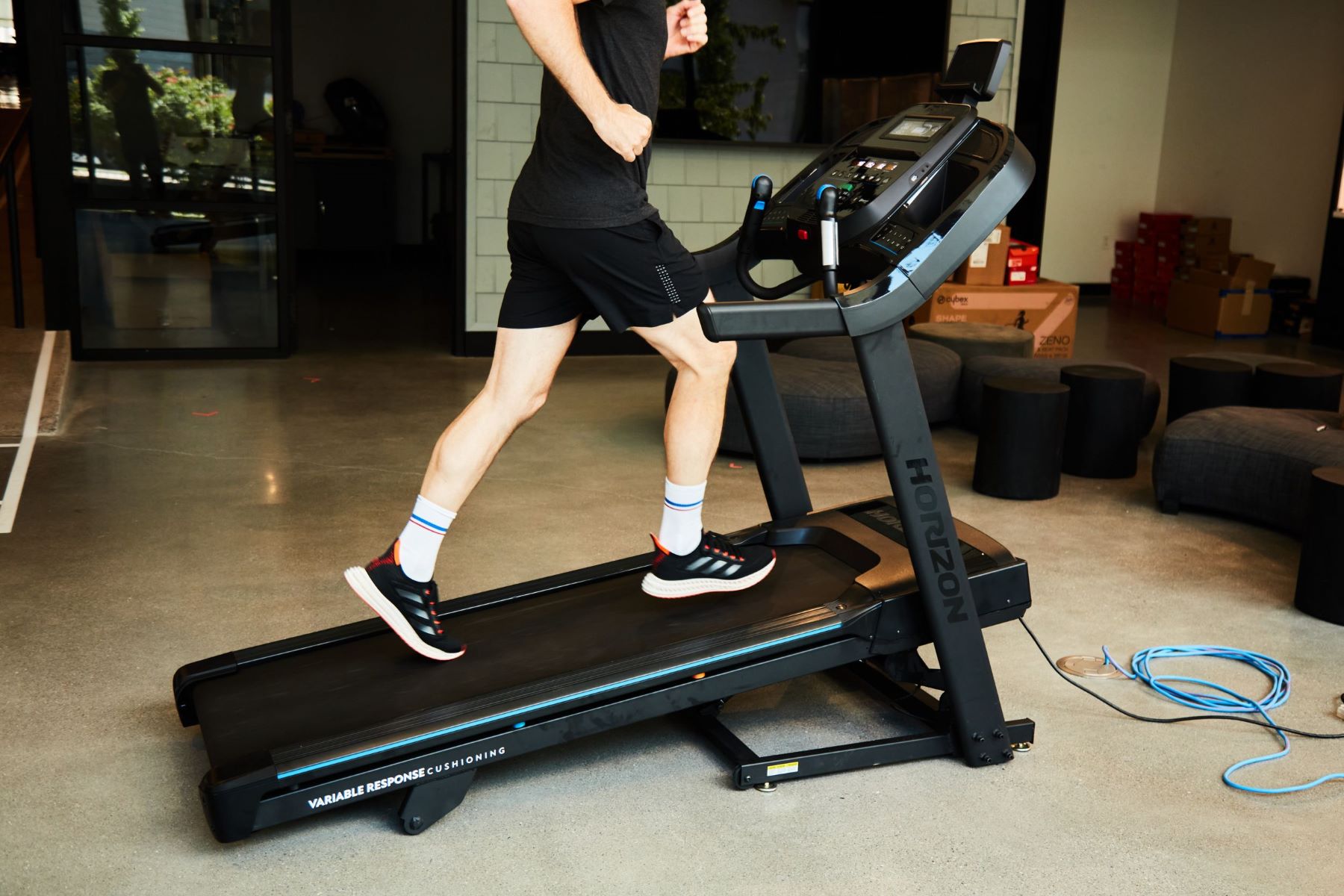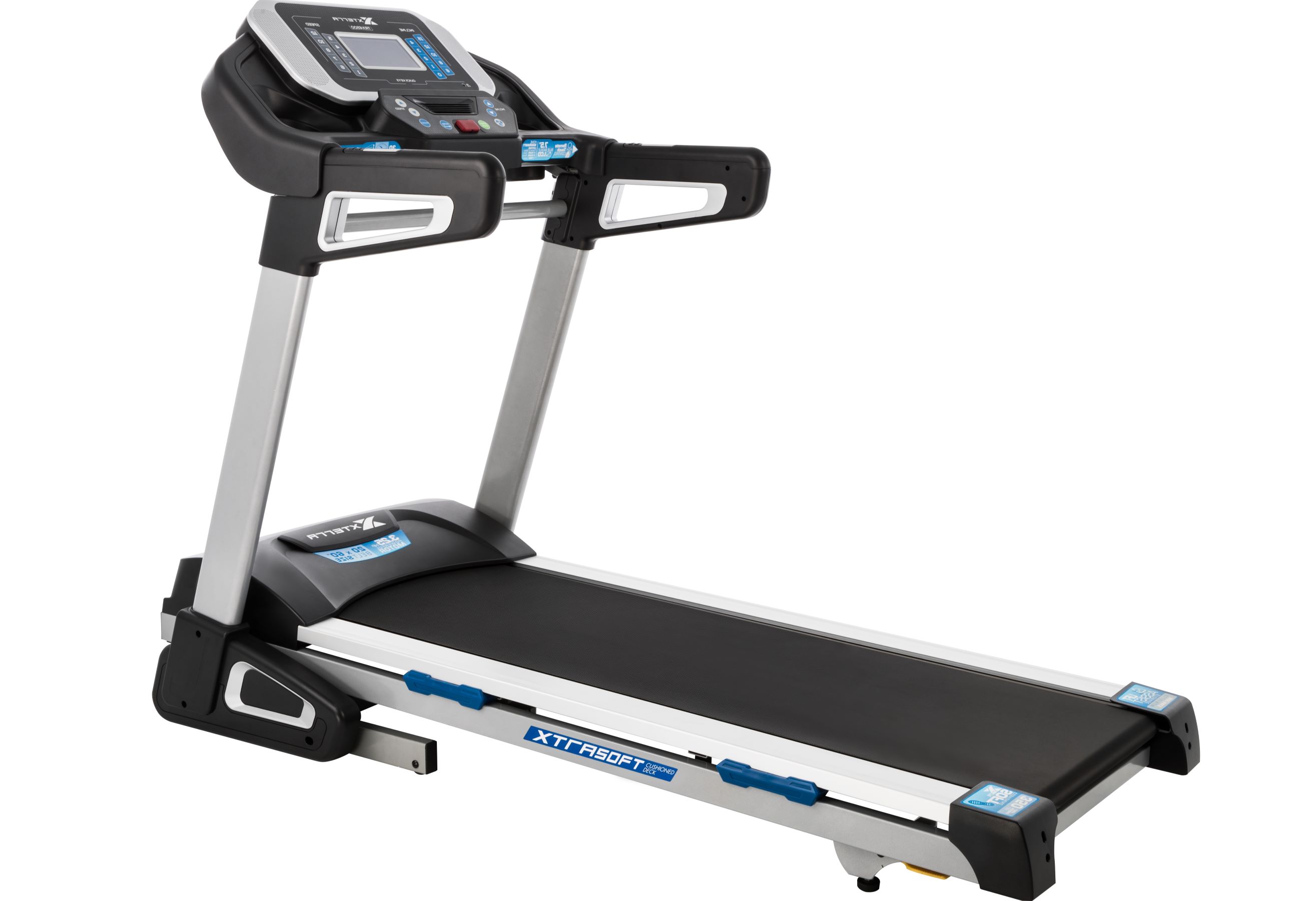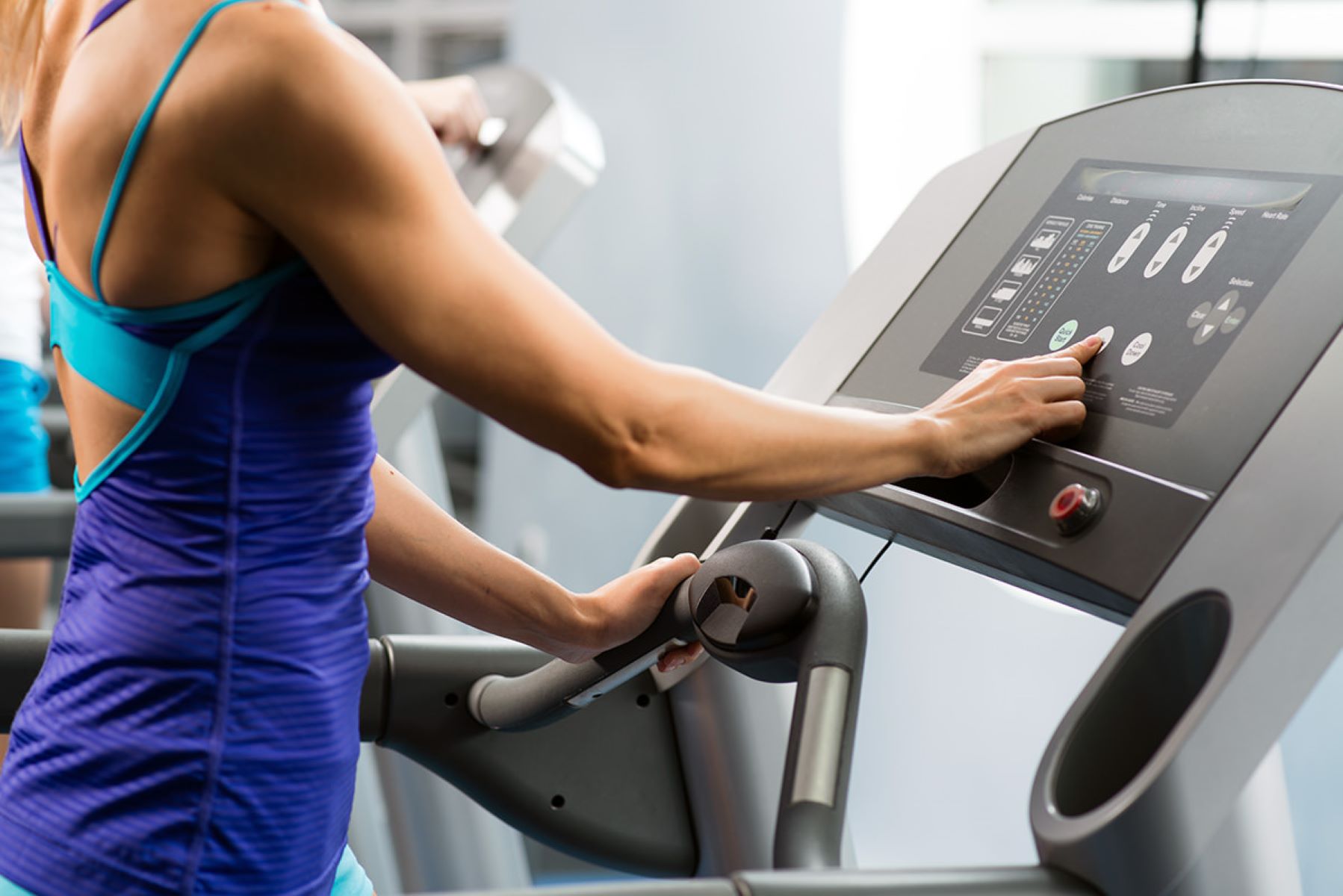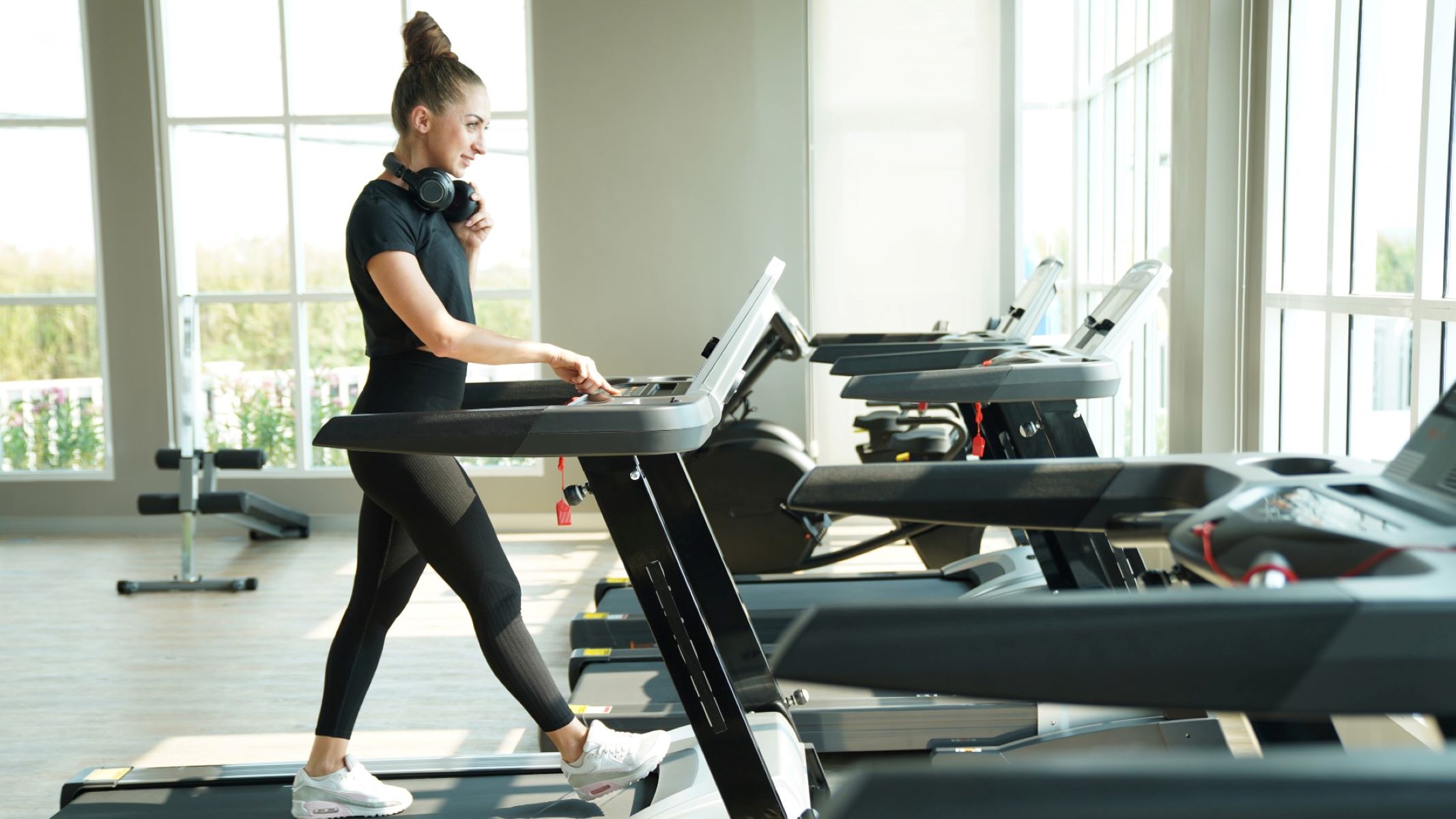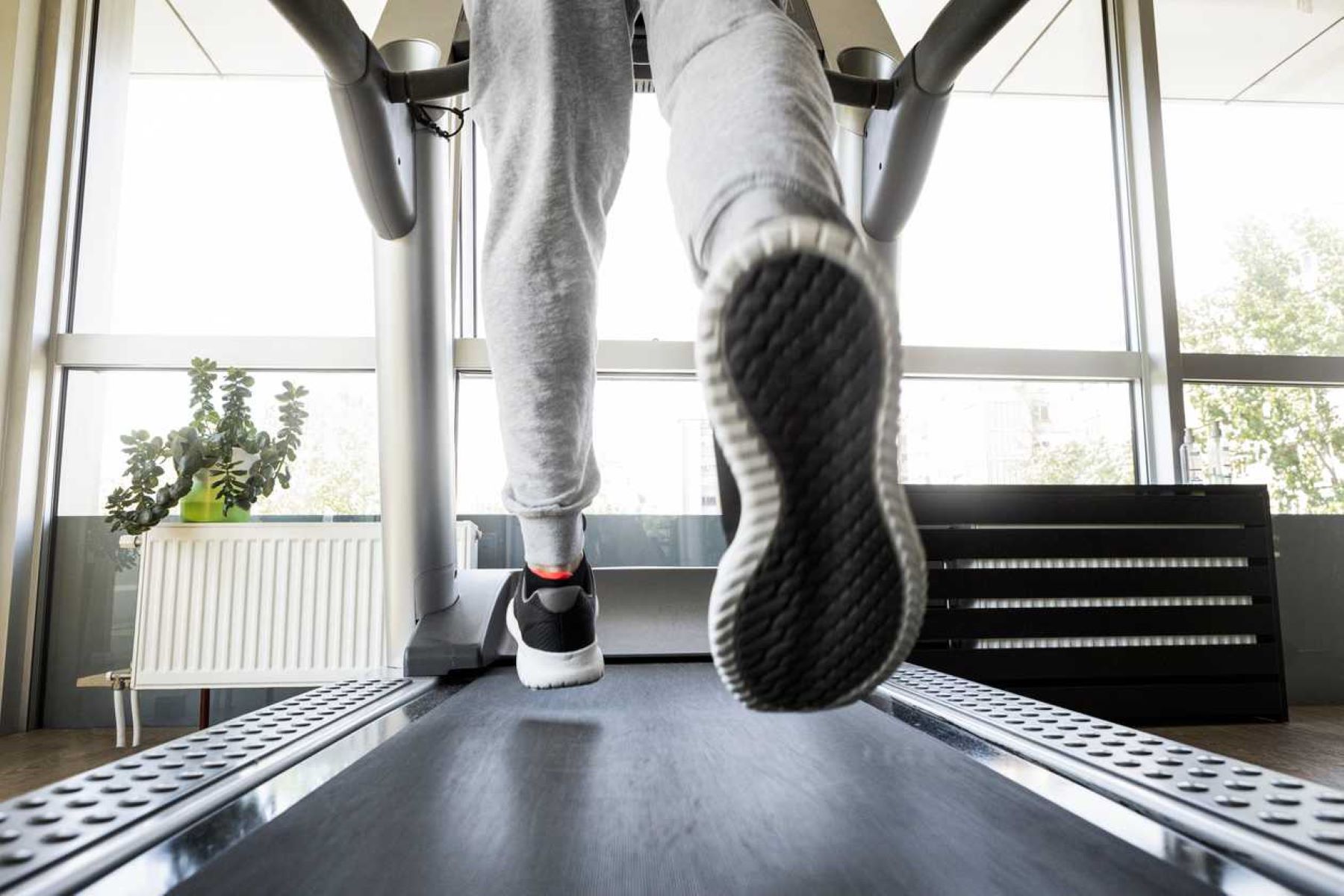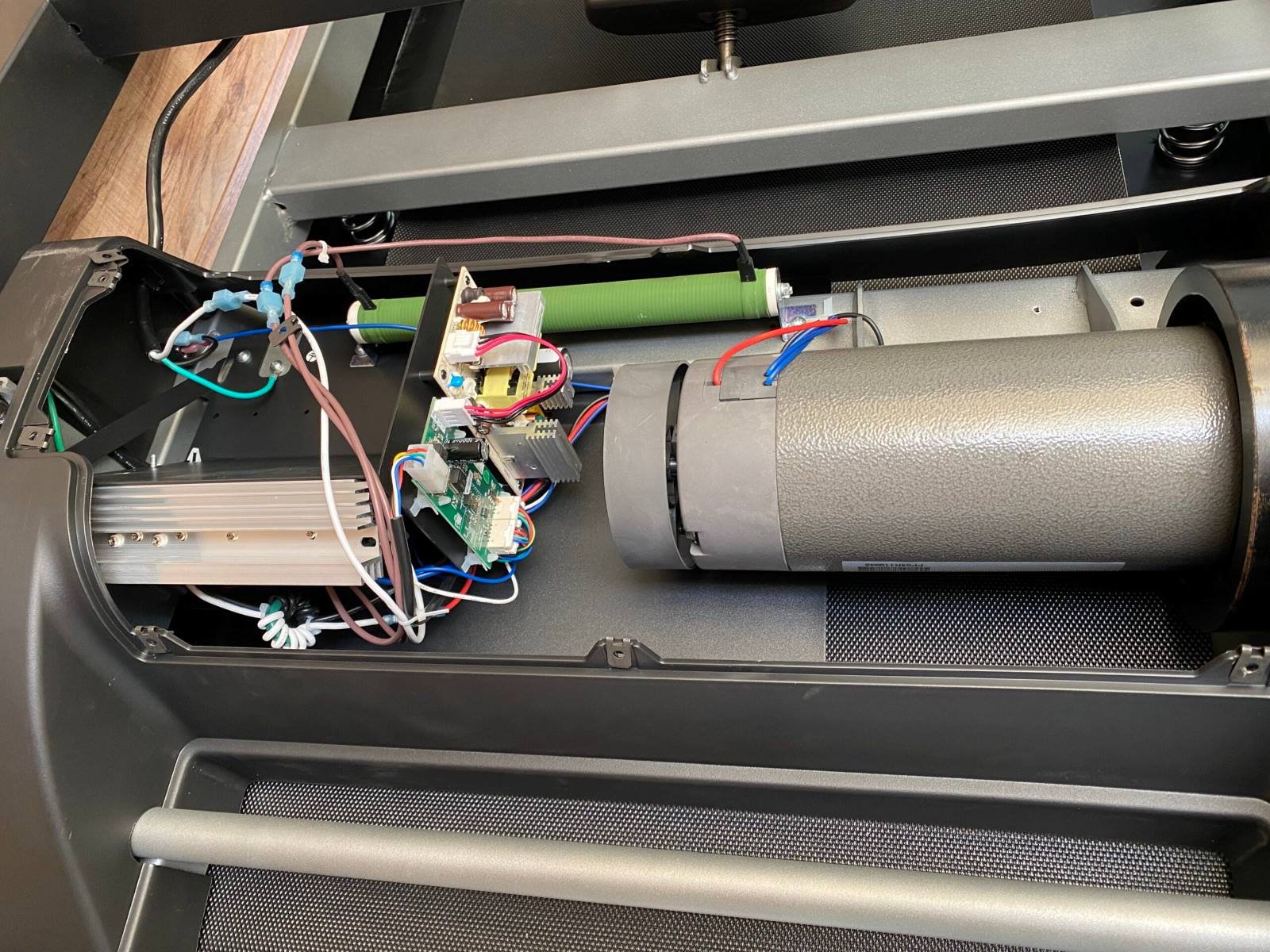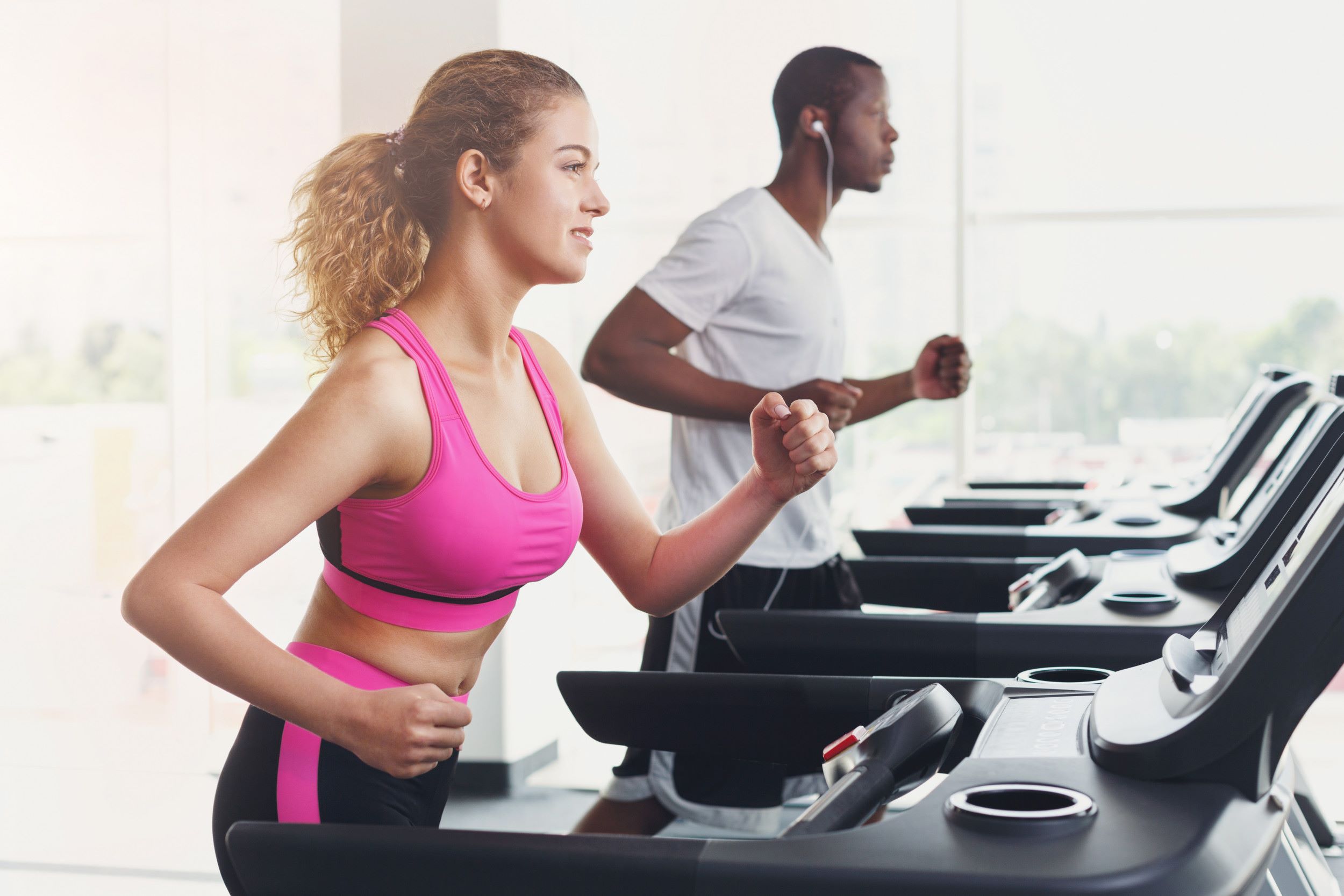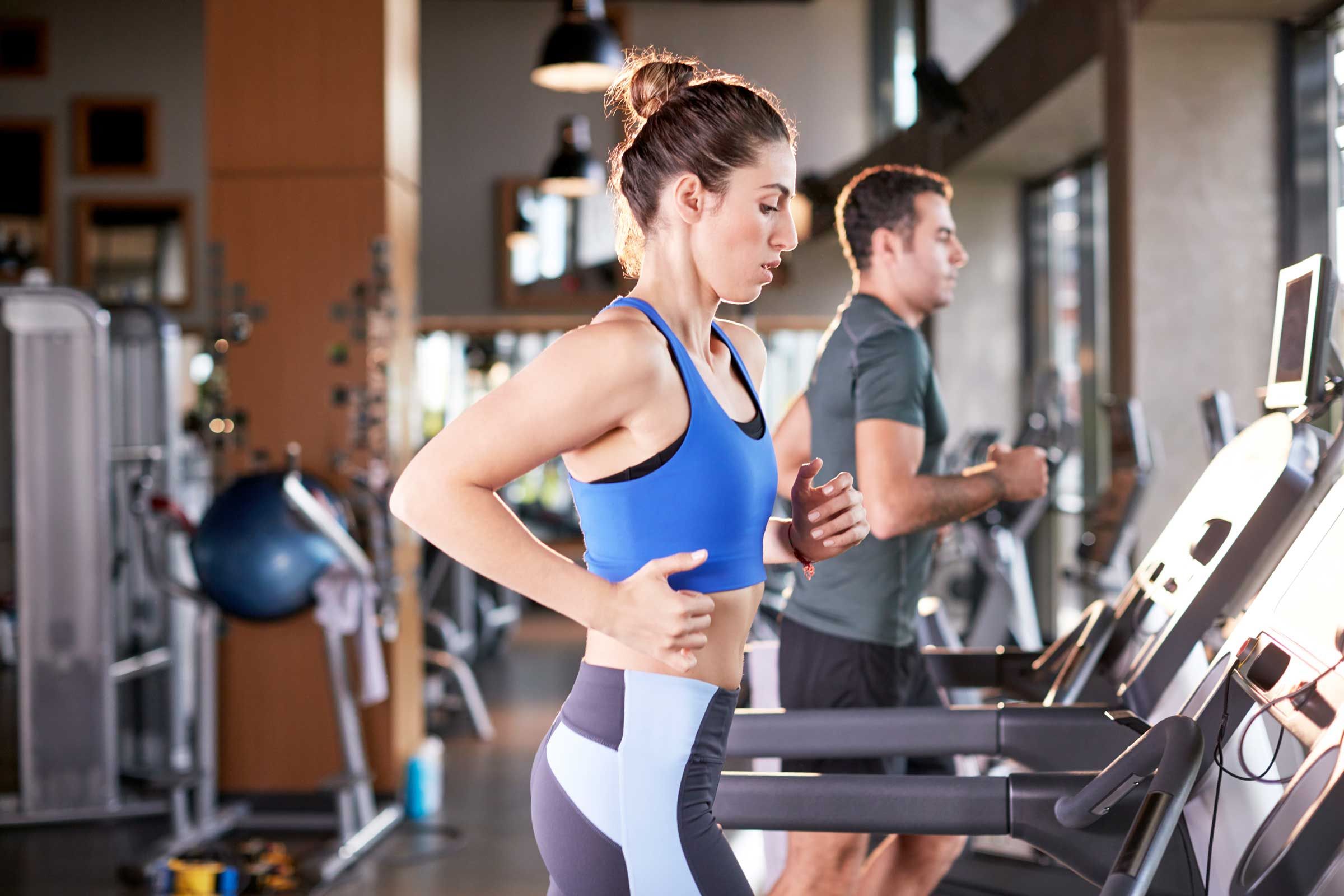

Featured
How To Start A Workout On The Treadmill
Modified: October 25, 2023
Learn how to start on the treadmill with our featured guide. Begin your fitness journey and achieve your fitness goals.
Introduction
Welcome to the world of running on the treadmill! Whether you’re a beginner or a seasoned runner looking for a change of pace, the treadmill can be an excellent tool for achieving your fitness goals. Running on a treadmill offers convenience, control, and a variety of workout options that can help you improve your cardiovascular health and boost your endurance.
In this article, we will guide you through the basics of starting your treadmill journey. We will cover everything from getting familiar with the machine to maintaining proper form and technique during your workout. So, let’s lace up our shoes and get started!
Running on a treadmill provides a controlled environment to exercise, regardless of the weather outside. It allows you to adjust the intensity and incline of your workout, making it suitable for beginners and advanced runners alike. Plus, the built-in features like heart rate monitoring, calorie tracking, and pre-set programs make it easy to track your progress.
If you’re new to running or haven’t been physically active for a while, the treadmill offers a forgiving surface and a reduced impact on your joints compared to running on pavement. This can help to minimize the risk of injuries and provide a safer environment for training.
Whether you’re aiming to lose weight, improve your cardiovascular fitness, or train for a race, the treadmill is a versatile tool that can help you achieve your fitness goals. By following proper techniques, maintaining a consistent workout routine, and making smart choices, you’ll be well on your way to reaping the benefits of running on the treadmill.
Getting Familiar with the Treadmill
Before you lace up your running shoes and hop on the treadmill, it’s important to familiarize yourself with the machine. Understanding its different components and features will ensure a safe and effective workout. Let’s take a closer look at what you need to know:
1. Control Panel: The control panel is where you’ll find all the buttons and settings to control your workout. It typically includes buttons for power on/off, speed adjustments, incline adjustments, and pre-set workout programs. Familiarize yourself with the layout and functions of the control panel before starting your workout.
2. Safety Key: Most treadmills come with a safety key that needs to be attached to your clothing while you’re running. In case of any mishap or loss of balance, the key can be pulled, automatically stopping the treadmill. Always ensure that the safety key is securely attached to your clothing before starting your workout.
3. Start/Stop Button: The start/stop button is your go-to control for starting and stopping the treadmill. Press it once to start the belt moving, and press it again to stop it. Familiarize yourself with the location and functionality of this button so that you can easily start and stop the treadmill as needed.
4. Speed Adjustment: The speed adjustment buttons allow you to increase or decrease the belt speed. Start at a comfortable speed and gradually increase it as you warm up. When adjusting the speed, do so gradually to allow your body to acclimate to the changes.
5. Incline Adjustment: Many treadmills offer an incline feature that allows you to simulate running uphill. This is a great way to add variety and intensity to your workout. If you’re new to incline training, start with a small incline and gradually increase it as your fitness improves.
6. Safety Rails: The treadmill usually has safety rails on either side of the belt. While these can provide support, it’s important to avoid relying on them too heavily while running. Using the rails excessively can compromise your natural running form and may increase the risk of injuries.
Take the time to read the user manual or watch instructional videos provided by the manufacturer to fully understand the features and functions of your specific treadmill model. Understanding how to operate the treadmill correctly will not only ensure your safety but also help you get the most out of your workouts.
Choosing the Right Shoes and Clothing
When it comes to running on the treadmill, having the right shoes and clothing can make a significant difference in your comfort and performance. Let’s delve into some essential factors to consider when selecting the appropriate footwear and attire for your treadmill workouts:
1. Shoes: Investing in a good pair of running shoes is crucial to protect your feet and prevent injuries. Look for shoes specifically designed for running, with proper cushioning, support, and stability. It’s recommended to visit a specialty running store where experts can analyze your gait and help you find the perfect pair of shoes that suit your feet and running style.
2. Clothing: When it comes to choosing clothing for your treadmill workouts, prioritize comfort and breathability. Opt for moisture-wicking fabrics that will keep you cool and dry during your run. Avoid clothing that is too tight or restrictive, as it can impede your range of motion. Additionally, dress in layers to accommodate changes in temperature and ensure that you have the flexibility to adjust your clothing as needed.
3. Socks: Don’t overlook the importance of selecting suitable socks for your treadmill runs. Look for moisture-wicking socks that provide cushioning and minimize friction to prevent blisters. Avoid cotton socks as they tend to retain moisture and can lead to discomfort and blisters.
4. Consider your Running Style: If you have a specific running style or foot condition, such as overpronation or high arches, you may benefit from shoes that offer extra support or stability features. Consult with a podiatrist or a knowledgeable running specialist to determine the best footwear options for your individual needs.
5. Replace Worn-out Shoes: As you log more miles on the treadmill, keep an eye on the wear and tear of your running shoes. It’s recommended to replace them every 300-500 miles or when you notice signs of significant wear, such as flattened cushioning or visible damage. Worn-out shoes can lead to discomfort and increase the risk of injuries.
Remember, wearing the right shoes and clothing is not only about comfort but also about preventing injuries and optimizing your performance on the treadmill. Investing in high-quality gear that fits well and suits your running style will make your workouts more enjoyable and help you reach your fitness goals more effectively.
Warming Up and Stretching
Before starting your treadmill workout, it’s crucial to properly warm up your body and engage in dynamic stretching exercises. Warming up prepares your muscles, increases blood flow, and reduces the risk of injury. Follow these steps to ensure an effective warm-up session:
1. Start with a Brisk Walk: Begin your warm-up by walking briskly on the treadmill for 5-10 minutes. This gradually elevates your heart rate and increases blood flow to your muscles. Focus on maintaining good posture and swinging your arms naturally as you walk.
2. Dynamic Stretches: After your brisk walk, incorporate some dynamic stretches to further loosen up your muscles and increase your range of motion. Dynamic stretching involves controlled movements that mimic activities you will perform during your workout. Examples include leg swings, arm circles, high knees, and walking lunges. Perform each stretch for 10-12 repetitions on each side.
3. Hip Openers: Pay special attention to stretching your hips, as they tend to get tight from sitting for long periods of time. Perform exercises such as hip circles, standing leg swings, or hip flexor stretches by stepping forward into a lunge position.
4. Calf Stretches: Stretch your calves by standing on the edge of the treadmill surface with your heels hanging off. Gently lower your heels and feel the stretch in your calves. Hold for 20-30 seconds and repeat a few times.
5. Dynamic Squats: Perform a few sets of dynamic squats to engage your lower body and warm up your leg muscles. Stand with your feet shoulder-width apart, lower into a squat position, and then rise back up. Repeat for 10-12 repetitions.
6. Shoulder Rolls and Arm Circles: Loosen up your shoulders and upper body by doing shoulder rolls and arm circles. Roll your shoulders forward and backward in a smooth motion, followed by making small and large circles with your arms.
Remember that warming up and stretching should never be rushed. Take your time to properly prepare your body and gently ease into each exercise. Listen to your body and adjust the intensity of the stretches accordingly. If you feel any pain or discomfort, modify or skip the exercise.
By incorporating warming up and dynamic stretching into your pre-treadmill routine, you’ll enhance your performance, reduce the risk of injury, and promote better overall flexibility and mobility in your workouts.
Adjusting the Treadmill Settings
When using a treadmill, it’s essential to adjust the settings according to your fitness level and workout goals. Properly adjusting the speed and incline can help you optimize your workout and challenge yourself appropriately. Here’s what you need to know:
1. Setting the Speed: The speed setting determines how fast the treadmill belt moves. If you’re new to running or just starting out, begin with a comfortable and manageable speed. Gradually increase the speed as you warm up and get into your stride. Aim for a pace that allows you to maintain good form and talk comfortably without feeling breathless.
2. Increasing the Intensity: To challenge yourself and increase the intensity of your workout, consider adjusting the incline of the treadmill. By raising the incline, you can simulate running uphill, which engages more muscles and burns more calories. Start with a small incline and gradually increase it as you build strength and endurance.
3. Interval Training: Treadmills often have pre-set interval training programs that alternate between periods of higher intensity and lower intensity. These programs can provide a varied and effective workout. Experiment with different interval programs to challenge yourself and keep your workouts interesting.
4. Use the Heart Rate Monitor: Many treadmills come equipped with heart rate monitors that allow you to track your heart rate during your workout. This feature can help you stay within your target heart rate zone and optimize your cardiovascular training. Consult with a fitness professional to determine your target heart rate range based on your fitness goals.
5. Customizing Your Workout: Most treadmills offer options to customize your workout, such as creating specific distances, time intervals, or calorie targets. Utilize these features to tailor your workout to your specific goals. Experiment with different settings to challenge yourself and keep your workouts engaging.
Remember, adjusting the treadmill settings is a personal preference and should be done based on your fitness level and comfort. Listen to your body and make adjustments that allow you to exercise safely and effectively. It’s important to challenge yourself, but also to find a balance that allows you to maintain good form and avoid overexertion.
By optimizing the treadmill settings to suit your individual needs, you can create a more personalized and effective workout experience. Don’t be afraid to experiment and find the settings that work best for you.
Starting Slow and Gradually Increasing Speed
When starting your treadmill workout, it’s important to pace yourself and begin at a comfortable speed. Starting slow allows your muscles to warm up and gradually adapt to the exercise. Here are some tips for starting your treadmill workout on the right foot:
1. Begin with a Warm-up: Before increasing the speed, start with a warm-up period of walking briskly. This helps prepare your muscles and cardiovascular system for the more intense portion of your workout. Aim for 5-10 minutes of brisk walking to elevate your heart rate and increase blood flow to your muscles.
2. Find Your Comfortable Pace: Once you’re warmed up, gradually increase the speed to find a comfortable running pace. It’s important to choose a speed where you feel challenged, but still in control. Avoid the temptation to start too fast, as this can lead to fatigue or loss of proper form. Remember, your pace will depend on your fitness level and individual capabilities.
3. Monitor Your Breathing: Pay attention to your breathing as you pick up the pace. Your breath should be rhythmic and controlled. If you find yourself gasping for air or unable to speak in full sentences, slow down the speed until you regain your composure. Proper breathing ensures that your muscles receive enough oxygen and can help prevent side stitches or muscle cramps.
4. Gradually Increase Speed: As your fitness level improves and you feel more comfortable, gradually increase the speed of the treadmill. It’s recommended to increase the speed by small increments, such as 0.1 or 0.2 mph, every few minutes. This gradual progression allows your body to adapt and adjust to the faster pace, reducing the risk of strain or injury.
5. Listen to Your Body: Pay attention to any signs of fatigue or discomfort during your workout and adjust the speed accordingly. It’s important to push yourself, but within your limits. If you experience pain or feel light-headed, stop the treadmill and give yourself time to recover. It’s better to take breaks and slowly build endurance over time rather than overexerting yourself.
Remember, starting slow and gradually increasing your speed is key to building endurance and preventing injuries. While it may be tempting to go all out from the beginning, it’s important to listen to your body and progress at a pace that feels comfortable and sustainable.
By implementing a gradual speed increase in your treadmill workouts, you can build strength, improve stamina, and achieve your fitness goals safely and effectively.
Maintaining Proper Form and Technique
Proper form and technique are crucial when it comes to running on the treadmill. Good form not only helps prevent injuries but also allows you to maximize your efficiency and get the most out of your workouts. Here are some tips to help you maintain proper form and technique:
1. Posture: Keep your posture upright and relaxed. Avoid slouching or leaning forward excessively. Engage your core muscles to maintain stability and proper alignment. Imagine a string pulling you up from the top of your head, keeping your spine elongated.
2. Arm Position: Your arms should be relaxed and bent at a 90-degree angle. Avoid crossing your arms in front of your body or swinging them too forcefully. Your arms should swing naturally and in sync with your stride, helping to maintain balance and momentum.
3. Foot Placement: Aim for a midfoot strike when running on the treadmill. Land with your foot directly underneath your body, not in front of you. This helps to reduce the impact on your joints and improves your running efficiency. Avoid excessive heel striking, as it can lead to overpronation and increase the risk of injuries.
4. Stride Length: Maintain a comfortable and natural stride length. Overstriding (taking overly long steps) or understriding (taking short, choppy steps) can lead to inefficient movement and increased strain on your muscles and joints. Find a stride length that feels natural and allows for a smooth and efficient running motion.
5. Cadence: Aim for a higher cadence (the number of steps per minute). A cadence of around 170-180 steps per minute is generally recommended for efficient running. This helps reduce the impact on your legs and increases your running speed without overexertion. A quicker cadence can also help improve your running form and reduce the risk of overstriding.
6. Breathing: Focus on breathing in a controlled and rhythmic manner. Take deep breaths in through your nose and exhale fully through your mouth. Coordinate your breathing with your running stride, taking deeper breaths as your intensity increases. This provides your muscles with sufficient oxygen for optimal performance.
7. Eye Focus: Look straight ahead or slightly downward, keeping your gaze focused on the console or a fixed point in front of you. Avoid looking down at your feet, as this can disrupt your balance and posture.
Remember, maintaining proper form and technique takes practice and awareness. Initially, you may need to consciously focus on these tips, but with time, they will become more natural. Regularly monitoring your form and making adjustments as needed can help prevent injuries, improve efficiency, and enhance your overall running experience on the treadmill.
Monitoring Heart Rate and Breathing
Monitoring your heart rate and breathing during your treadmill workouts is essential to gauge your intensity level and ensure you’re exercising at an appropriate level. By keeping a close eye on these vital signs, you can optimize your workouts and make adjustments as needed. Here’s how to effectively monitor your heart rate and breathing:
1. Heart Rate Zones: Understanding and training within your target heart rate zones can help you optimize your cardiovascular fitness and achieve specific fitness goals. Calculate your maximum heart rate by subtracting your age from 220. Then, determine your target heart rate zones based on your fitness level and goals. For example, the moderate intensity zone is typically around 50-70% of your maximum heart rate, while the vigorous intensity zone is around 70-85%. Use a heart rate monitor or check your pulse regularly to ensure you’re within your desired range.
2. Pay Attention to Your Breathing: Focus on your breathing pattern while running on the treadmill. Aim for a rhythmic and controlled pattern, taking deep breaths in through your nose and exhaling fully through your mouth. If you find yourself gasping for air or struggling to breathe, it may indicate that you’re pushing too hard and need to lower the intensity. Take time to recover and regain control of your breathing before continuing your workout.
3. Rate of Perceived Exertion (RPE): Another method to monitor your intensity level is by using the Rate of Perceived Exertion (RPE) scale. This scale allows you to subjectively rate how hard you feel your workout is on a scale of 1 to 10. Aim to exercise at an intensity level that is challenging but sustainable. If your RPE is too low, you may not be pushing yourself hard enough, while if it’s too high, it may indicate overexertion.
4. Use Heart Rate-monitoring Technology: Consider incorporating heart rate-monitoring technology, such as a chest strap or wrist-worn device, to conveniently and accurately track your heart rate during your treadmill workouts. These devices can provide real-time feedback and help you stay within your target heart rate zones. They can also provide valuable data to assess your cardiovascular fitness progress over time.
5. Adjust Intensity as Needed: Based on your heart rate and breathing, be prepared to adjust the intensity of your treadmill workout. If you’re exercising beyond your target heart rate zone or struggling to breathe comfortably, decrease the speed or incline to allow for recovery. Conversely, if you find yourself not challenging enough, you can gradually increase the intensity to push yourself a little further.
Monitoring your heart rate and breathing during your treadmill workouts not only helps you exercise within your desired target zones but also ensures your safety and prevents overexertion. By fine-tuning your intensity level, you can effectively build cardiovascular fitness, improve endurance, and reach your fitness goals more efficiently.
Hydration and Nutrition Tips
Proper hydration and nutrition are essential for optimal performance and recovery during your treadmill workouts. Staying hydrated and fueling your body with the right nutrients will help you maintain energy levels and maximize the benefits of your exercise. Here are some important hydration and nutrition tips to keep in mind:
1. Hydration Guidelines: Drink an adequate amount of water before, during, and after your treadmill workouts. Aim to drink at least 8 ounces (240 ml) of water 30 minutes before exercising. During your workout, sip on water regularly to stay hydrated. After your workout, replenish the fluids you’ve lost by drinking water. Adjust your intake based on factors such as exercise duration, intensity, and environmental conditions.
2. Electrolyte Balance: When you sweat, you lose not only water but also important electrolytes like sodium and potassium. Replenishing these electrolytes is crucial for maintaining proper muscle function and preventing dehydration. Consider including electrolyte-rich beverages or sports drinks in your workout routine, especially for longer or more intense treadmill sessions. Alternatively, you can also replenish electrolytes through natural sources like coconut water or incorporating electrolyte supplements as per your doctor’s recommendations.
3. Pre-Workout Nutrition: Fueling your body with a balanced meal or snack before your treadmill workout is important to provide energy and sustain your performance. Opt for a combination of carbohydrates, protein, and healthy fats. Choose easily digestible foods like fruit with yogurt or nut butter, whole grain toast with avocado or lean protein, or oatmeal with berries. Experiment with different options to find what works best for you in terms of providing sustained energy without causing digestive discomfort.
4. Post-Workout Nutrition: After your treadmill workout, prioritize post-exercise nutrition to replenish energy stores and facilitate muscle recovery. Aim to consume a balanced meal or snack containing carbohydrates and protein within 30-60 minutes of completing your workout. This could include a protein shake, a chicken salad with whole grain bread, or a smoothie made with fruits, vegetables, and a scoop of protein powder.
5. Listen to Your Body: Pay attention to your body’s signals and adjust your hydration and nutrition accordingly. Everyone’s needs vary, and it’s important to find a routine that works best for you. Drink when you’re thirsty, eat when you’re hungry, and make choices that nourish and support your individual fitness goals.
Remember, staying hydrated and fueling your body with the right nutrients before and after your treadmill workouts will optimize your performance and help you recover effectively. It’s important to develop healthy habits and listen to your body’s needs to ensure you remain adequately hydrated and nourished.
Staying Motivated and Setting Goals
Staying motivated is key to maintaining a consistent treadmill workout routine. Setting goals and keeping yourself inspired will help you stay focused, overcome challenges, and make progress towards your fitness aspirations. Here are some tips to help you stay motivated and set meaningful goals:
1. Set SMART Goals: Ensure your goals are Specific, Measurable, Attainable, Relevant, and Time-based (SMART). For example, instead of a vague goal like “I want to get in shape,” set a specific goal like “I want to run a 5K race in under 30 minutes within the next three months.” Having clear and achievable goals will provide direction and focus to your workouts.
2. Break It Down: Break your overarching goal into smaller, more manageable milestones. Celebrating these mini-achievements will provide a sense of accomplishment and keep you motivated. For instance, if your goal is to run a 5K race, start with a goal of running for five minutes straight without stopping and gradually increase your running time.
3. Track Your Progress: Keep a record of your workouts, including distance, time, speed, and any other relevant metrics. This will allow you to see your progress over time and provide a sense of accomplishment. Consider using a fitness tracking app, a journal, or a spreadsheet to keep track of your workouts and improvements.
4. Mix It Up: Avoid falling into a monotonous workout routine. Add variety to your treadmill workouts by incorporating different workouts, such as intervals, hills, or incline training. You can also listen to music, podcasts, or audiobooks to keep yourself entertained and engaged during longer workouts.
5. Find an Accountability Partner: Team up with a workout buddy or join a fitness community to help you stay accountable and motivated. Having someone to share your goals, challenges, and successes with can provide support and keep you on track.
6. Reward Yourself: Celebrate your achievements along the way. Treat yourself to a small reward when you reach a milestone or accomplish a specific goal. This helps to reinforce positive behavior and provides a little extra motivation to keep going.
7. Visualize Success: Imagine yourself achieving your fitness goals to stay motivated. Visualize how you will feel, the improved fitness level, and the sense of accomplishment. Use this visualization as motivation during challenging workouts or when you’re feeling demotivated.
Remember, staying motivated is a continuous process. Some days may be harder than others, but by setting meaningful goals, tracking your progress, and finding ways to keep yourself engaged and accountable, you can stay motivated and maintain a consistent treadmill workout routine.
Cool Down and Stretching Exercises
After completing a treadmill workout, it’s crucial to properly cool down and incorporate stretching exercises to help your body recover and prevent muscle stiffness or soreness. The cool down phase allows your heart rate to gradually return to its resting state and helps prevent blood from pooling in your legs. Here are some cool down and stretching exercises to include in your post-workout routine:
1. Brisk Walking: As you near the end of your treadmill workout, gradually decrease the speed and transition into a brisk walk. Continue walking for 5-10 minutes to gradually bring your heart rate down. This gentle movement helps promote circulation and aids in the removal of waste products like lactic acid from your muscles.
2. Deep Breathing: During your cool down, incorporate deep breathing exercises to help relax your body and calm your mind. Inhale deeply through your nose and exhale fully through your mouth. Focus on slowing down your breath and taking long, deep breaths, allowing for a sense of calm and relaxation.
3. Calf Stretches: After your walk, find a wall or stable support and perform calf stretches. Place one foot forward, leaning against the support with the knee slightly bent. Keep the back leg straight with the heel on the ground, and gently lean forward until you feel a stretch in the calf of the back leg. Hold the stretch for 20-30 seconds on each leg.
4. Hamstring Stretches: Stand with your feet hip-width apart and extend one leg straight in front of you. Keeping your back straight, gently lean forward at your hips until you feel a stretch in the back of the extended leg. Hold the stretch for 20-30 seconds and repeat on the other leg.
5. Quadriceps Stretches: Stand upright and lift one foot toward your glutes, grasping your ankle or foot with your hand. Gently pull your foot toward your glutes until you feel a stretch in the front of your thigh. Hold the stretch for 20-30 seconds and switch to the other leg.
6. Hip Flexor Stretches: Step forward with your right foot into a lunge position. Keep your back straight and your chest upright. Sink your hips forward until you feel a stretch in the front of your left hip. Hold for 20-30 seconds and repeat on the other side.
7. Shoulder and Chest Stretches: Interlace your fingers behind your back and gently squeeze your shoulder blades together, allowing for a stretch in your chest and shoulders. Hold for 20-30 seconds and release. You can also perform doorway stretches by placing your forearm against a doorframe, then gently lean forward to stretch your chest and shoulders.
Cooling down and incorporating stretching exercises after your treadmill workouts is essential for reducing muscle soreness and promoting flexibility. Allow yourself sufficient time for these exercises to properly relax and elongate your muscles. Remember to perform stretches in a controlled and pain-free manner, respecting your body’s limits.
Safety Tips and Precautions
When using a treadmill, it’s important to prioritize safety to prevent accidents and injuries. By following these safety tips and precautions, you can ensure a safe and enjoyable treadmill workout experience:
1. Read the User Manual: Familiarize yourself with the specific instructions and safety precautions outlined in the user manual of your treadmill. This will help you understand the machine’s features, limitations, and safety recommendations provided by the manufacturer.
2. Warm-Up and Cool Down: Always incorporate a proper warm-up and cool-down into your treadmill routine. This prepares your body for exercise and helps prevent muscle strains or injuries. Additionally, gradually reduce the speed during your cool-down to allow your heart rate to return to normal gradually.
3. Use the Safety Key: Ensure the safety key is properly attached to your clothing while using the treadmill. This is an important safety feature that allows the treadmill to stop immediately in case of an emergency or loss of balance.
4. Wear Appropriate Attire: Dress comfortably and wear appropriate footwear when using the treadmill. Choose supportive running shoes that fit well and provide adequate cushioning and stability. Avoid loose clothing that may get caught in the moving parts of the treadmill.
5. Start with Slow Speeds: Begin your treadmill workout at a slow and comfortable speed, especially if you’re new to running or haven’t exercised in a while. Gradually increase the speed as you warm up and find your rhythm.
6. Use Handrails Sparingly: While the handrails can provide support, avoid relying on them too heavily while running. Using the handrails excessively can disrupt your natural running form and balance. However, it’s acceptable to use them briefly for stability, such as during warm-up or cool-down periods.
7. Stay Hydrated: Drink water before, during, and after your treadmill workout to stay properly hydrated. Dehydration can lead to fatigue, dizziness, and decreased performance. Keep a water bottle within reach and sip on water regularly throughout your workout.
8. Listen to Your Body: Pay attention to any signs of discomfort, pain, or excessive fatigue during your treadmill workout. If you feel any unusual pain (especially in your joints), dizziness, or shortness of breath, stop exercising and seek medical attention if necessary.
9. Keep a Safe Distance: If multiple treadmills are in use simultaneously, maintain a safe distance between yourself and others to prevent collisions or interfering with each other’s workout space. Respect the personal space and boundaries of fellow gym-goers.
10. Regular Maintenance: Keep your treadmill in good working condition by regularly cleaning and maintaining it. Follow the manufacturer’s guidelines for maintenance and ensure that all components, such as the belt and handrails, are in proper working order.
Remember, safety should always be a top priority when using a treadmill. By following these safety tips and precautions, you reduce the risk of accidents and injuries, allowing for a safe and effective workout experience.
Conclusion
Congratulations on completing this comprehensive guide to starting on the treadmill! By now, you should have a good understanding of the fundamentals of using a treadmill effectively and safely. Incorporating these tips into your treadmill workouts will help you make the most out of your exercise routine and achieve your fitness goals.
Remember, the key to successful treadmill workouts is to start slowly, gradually increase speed and intensity, and maintain proper form and technique. Be sure to warm up before each workout and cool down afterwards, incorporating stretching exercises to prevent muscle soreness and promote flexibility.
In addition, staying motivated and setting goals play a crucial role in staying consistent with your treadmill workouts. Set SMART goals, track your progress, and find ways to keep yourself inspired and accountable. And don’t forget to prioritize proper hydration and nutrition to fuel your body for optimal performance and recovery.
Finally, always prioritize safety when using the treadmill. Familiarize yourself with the specific features and safety precautions of your machine, wear suitable attire, and listen to your body to prevent injuries. Following these safety guidelines will ensure a safe and enjoyable treadmill workout experience.
Now, it’s time to put this knowledge into action. Lace up your shoes, step onto the treadmill, and embark on your fitness journey. Whether you’re aiming for weight loss, improving cardiovascular health, or training for a race, the treadmill can be your powerful ally in achieving your fitness goals.
So, embrace the convenience, control, and versatility that the treadmill offers and make it your go-to fitness companion. With determination, consistency, and the tips you’ve learned, you’re well on your way to reaching new levels of fitness on the treadmill!


